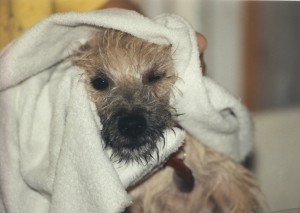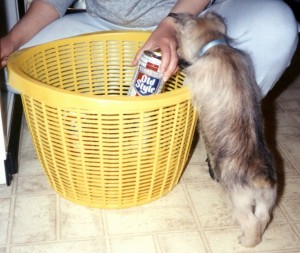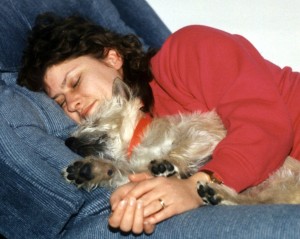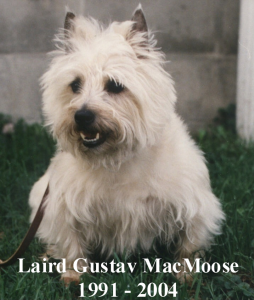< Updated 2JAN19 >
< A version of this article was published in the September 2018 issue of Downeast Dog News >
< A short link to this article on my blog – http://bit.ly/Things-Gus-Dominance >
In a recent interview, I was asked a series of questions about how to choose a dog trainer. One of the questions was “What would you like to have known when you started training dogs?” This post will be the first of a series of article inspired by that question.
This series of articles has since been renamed Things I Wish I Had Known Before I Selected My First Dog, and you can find a complete list of posts in the series at < http://bit.ly/ThingsIWishIHadKnown >

In the spring of 1991, I had a new 12-week old Cairn Terrier puppy named Gus. I had no knowledge of dog training, but a desire to learn. I started to learn by reading two of the most popular dog training books at the time; How to Be Your Dog’s Best Friend and Mother Knows Best. The basic premise of both books was that a dog is a wolf and the best way to train and care for a dog is to dominate it like an Alpha wolf would dominate a wolf pup. My wife and I also enrolled ourselves and Gus in a puppy kindergarten class offered by the local dog club.
Our first night in puppy class was a complete disaster. I was told to command Gus to sit, and Gus failed to comply. Now, this was not a big deal to us nor a surprise, as we were well aware that Gus had no clue what we wanted him to do when we said the word “Sit.” However, Gus’ failure to comply was a massive deal to the two instructors. They told me, in no uncertain terms, that Gus was exerting his dominance and that I had to alpha roll him to show him that I was the Alpha. The alpha roll was precisely what the books we were reading recommended, so not knowing any better I did as I was told. As I grabbed Gus by the scruff and pinned him, he immediately began thrashing around underneath me, growling and snapping, and trying to connect his teeth with me, so that I would let him go. I know now that Gus was terrified but at the time believed I was doing the right thing.
The instructor now became even more adamant: “We can’t have that! Grab his muzzle and clamp it shut!” My instincts said “Whoa! That’s not safe!” but these people were the “experts” so I tried grabbing Gus’ muzzle in my hand. Instantly, I felt his canines puncture my palm. As my blood started dripping on the floor, Gus broke free and moved as far away from me as he could. There is something to be said for listening to your gut instincts. Gus followed his; I failed to pay attention to mine.
Unbeknownst to me at the time, everything that I had read and been taught about the alpha wolf rollover was based upon flawed knowledge. My puppy was afraid for his life, and it was my fault.
When we got back home, it was evident that the relationship between Gus and I was severely damaged. I was no longer being asked to “throw the ball” by the puppy with the joyously vibrating tail. Gus did not trust me, and I did not trust him. Over many months Gus and I learned to trust one another again, and training and behavior became something we both enjoyed. We were fortunate to discover Dr. Patricia McConnell where we learned about the wonders of reward-based training. We had fun; our dogs had fun and that should be a primary focus of training.
So this is what I would have liked to have known before I started training Gus.
- Just because something is in a book written by an alleged expert does not mean it is good advice or even factual.
- The study of wolf packs in the wild has taught us that a wolf pack is a family working cooperatively to survive to pass on their genes. Their survival depends on cooperation, NOT competition to be the alpha within the pack.
- The violent alpha roll described in the books I read has never been observed happening in a wolf pack. A wolf pup may voluntarily roll on its back and submit to an older wolf, but it is never physically forced to do so.
- Karen Overall is a veterinarian who is also one of the few vets that is also a Diplomate of the American College of Veterinary Behavior. She also has a PhD and is certified by the Animal Behavior Society as an Applied Animal Behaviorist. In other words, she is one of the leading experts on the planet on dog behavior. This is what she said about dominance at a PPG conference in 2016. “Dominance theory has shut off scientific research and has crept into medicine to the point where we think we can do things to animals whereby we are asking them to ‘submit’….dominance theory is insidious and has crept into everything we do with dogs and it’s wrong. It has gotten in the way of modern science and I’ve just about had it. Every single thing we do with dogs hurts them because we don’t see them as individuals or cognitive partners.” [ Emphasis Added ]
- In the 2017 documentary, Dogs, Cats and Scapegoats Overall sums it up very well when she states: “In the evolutionary literature “alpha” was just a shorthand for breeding. I’m the alpha – that you feel that you have to compete with a dog in your household over some imaginary rank, what does that say for how you live with people?” [ Emphasis Added ]
- The entire concept of dominance is not only an erroneous understanding of the dog-human relationship, but it is also counterproductive to a harmonious relationship with our dog and may cause aggression as it did with Gus.
Unfortunately the same bad advice I received in 1991 is still being promulgated today, in spite of the fact that major canine organizations such as the American Animal Hospital Association (AAHA), the American Veterinary Society of Animal Behavior (AVSAB), the Pet Professional Guild (PPG), the Association of Professional Dog Trainers (APDT), all warn of the use of dominance-based training.
Recommended Resources
Articles on Don’s Blog ( http://www.words-woofs-meows.com )
Things I Wish I Had Known Before I Selected My First Dog – Link Page – http://bit.ly/ThingsIWishIHadKnown
Dog Behavior – Dominance: Reality or Myth – http://bit.ly/Dominance-RealityorMyth
Thank You, PPG, and Gus Too! – from the May 2017 issue of the Pet Professional Guild journal, BARKS from the Guild – http://bit.ly/ThanksPPG-Gus
Podcasts from The Woof Meow Show
( http://www.woofmeowshow.com )
The Dominance and Alpha Myth – http://traffic.libsyn.com/woofmeowshow/WoofMeowShow-2010-03-21-The_Dominance_Myth.mp3
Prof. Chad Montrie and the documentary Tough Love: A Meditation on Dominance and Dogs – http://traffic.libsyn.com/woofmeowshow/WoofMeowShow-2013-01-26-Tough_Love_Chad_Montrie.mp3
Other Publications
BARKS from the Guild – May 2017 – Thank You, PPG , and Gus Too! – https://issuu.com/petprofessionalguild/docs/bftg_may_2017_online_edition_opt/58
Videos
Tough Love: A Meditation on Dominance and Dogs, Anchorhold Films, 2012 – https://www.youtube.com/watch?v=OIjMBfhyNDE
Dogs, Cats and Scapegoats – The Mind of Cesar Millan – https://vimeo.com/236013182
Dr. L. David Mech talks about the terms “alpha” and “beta” wolves and why they are no longer scientifically accurate – https://www.youtube.com/watch?v=tNtFgdwTsbU
Position Statements
American Veterinary Society of Animal Behavior AVSAB Position Statement on the Use of Dominance Theory in Behavior Modification of Animals – https://avsab.org/wp-content/uploads/2018/03/Dominance_Position_Statement_download-10-3-14.pdf
Association of Professional Dog Trainers – APDT Position Statement on Dominance and Dog Training – https://apdt.com/wp-content/uploads/2017/01/dominance-and-dog-training.pdf
Green Acres Kennel Shop Position Statement on Pet Friendly, Force-Free Pet Care – http://bit.ly/GAKS_Pet-Friendly
Green Acres Kennel Shop Position on the Use of Dominance and Punishment for the Training and Behavior Modification of Dogs – http://bit.ly/GAKS-Pos-NoPain-NoForceNoFear
The Pet Professional Guild – Position Statement – Dominance Theory in Animal Training – https://www.petprofessionalguild.com/DominanceTheoryPositionStatement
Books
Dog Smart: Evidence-based Training with The Science Dog, Linda P. Case, CreateSpace Independent Publishing Platform, 2018 – read a review at http://bit.ly/BkRvw-Case-DogSmart
Dogs: A New Understanding of Canine Origin, Behavior and Evolution, Raymond and Lorna Coppinger, University of Chicago Press, 2001.
Dominance: Fact or Fiction, Barry Eaton, 2002.
Dominance Theory and Dogs Version 1.0, James O’Heare, DogPsych Publishing, 2003.
Don’t Shoot the Dog – The New Art of Teaching and Training (2ndedition), Karen Pryor, Bantam Books, 1999.
On Talking Terms With Dogs: Calming Signals, Turid Rugaas, Dogwise Publishing, 2006.
Stress in Dogs, Martina Scholz and Clarissa von Reinhardt, Dogwise Publishing, 2007.
The Culture Clash, Jean Donaldson, James & Kenneth Publishers, 2005.
The Power of Positive Dog Training, Pat Miller, Howell Book House, 2001.
©2JAN19, Donald J. Hanson, All Rights Reserved
< Click for Copyright and Use Policy >








